WoodSolutions Fact Sheets are concise, one page descriptions of timber products and their benefits, scroll down to view.
More information about the application and use of timber products can be found in the WoodSolutions Design Guides.
Information about the environmental credentials of some products can be found in the Environmental Product Declarations
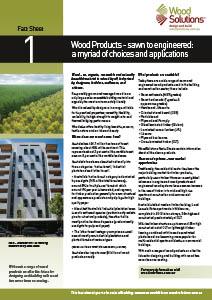
Fact Sheet 1 - Introduction
Wood – an, organic, renewable and naturally beautiful material is valued by all, but prized by designers, builders, craftsmen, and artisans.
Responsibly grown and managed wood is our only large scale renewable building material and arguably the most environmentally friendly.
Wood is valued by designers in a range of fields for its practical properties; versatility, flexibility, workability, its high strength to weight ratio and thermal bridging performance.
Wood also offers healthy living benefits, a warm, tactile nature and an inherent beauty.
In these guides you'll be introduced to wide range of sawn and engineered wood products used in the building and construction sectors, including:
• Sawn softwoods (MGP-grades)
• Sawn hardwoods (F-grades & appearance grades)
• Hardboard - Masonite
• Oriented strand board (OSB)
• Particleboard
• Plywood and Formply
• Glued laminated timber (Glulam)
• Laminated veneer lumber (LVL)
• I-beams
• Plywood box beams
• Cross laminated timber (CLT)
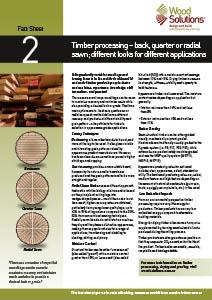
Fact Sheet 2 - Timber processing
Taking naturally variable round logs and turning them into the multitude of beautiful and useful timber products people desire and use takes, experience, knowledge, skill, innovation - and passion!
There are a several ways round logs can be sawn to maximise recovery and minimise waste while also providing a desired look or grade.
This fact sheet looks at the three main options and the grading process.
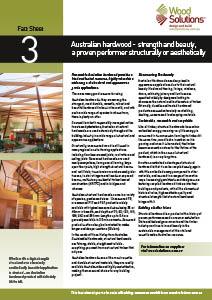
Fact Sheet 3 - Australian hardwoods
Renewable Australian hardwood is a tried and tested resource, highly valued in a wide range of structural and appearance grade applications.
There are many good reasons for using Australian hardwoods: they are among the strongest, most durable, versatile, robust and
beautiful hardwood timbers in the world, and with such a wide range of species to chose from, there is plenty on offer.
Sourced from both responsibly managed native forests and plantations, Australian structural hardwoods are used extensively throughout the building industry in a wide range of structural and appearance applications.
This fact sheet discusses their applications.
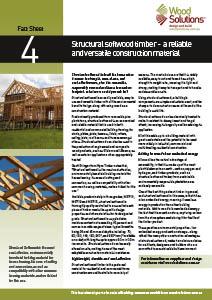
Fact Sheet 4 - Structural softwoods
Structural softwood ticks all the boxes when it comes to strength, ease-of-use, and cost-effectiveness, plus it is renewable, responsibly sourced and has a low carbon footprint - what more could you ask for?
Structural softwood is a readily available, easy to use and versatile timber.
This fact sheet discusses some of the advantages, common sizes and environmental benefits of structural softwoods.
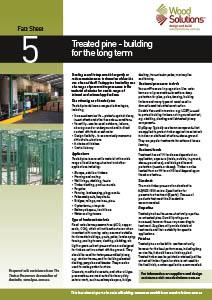
Fact Sheet 5 - Treated pine
Treating wood to improve its longevity or reduce maintenance is almost as old as the use of wood itself.
Today, pine treated by one of a range of preservative processes is the material of choice for a wide range of internal and external applications.
This fact sheet discusses the advantages of treated pine and explains some common treatments.
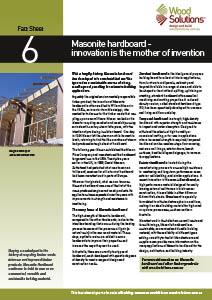
Fact Sheet 6 - Masonite hardboard
Masonite hardboard has developed into a material that can’t be ignored as a sustainable source of strong, weatherproof panelling for extensive building applications.
This fact sheet discusses the history and use of Masonite.
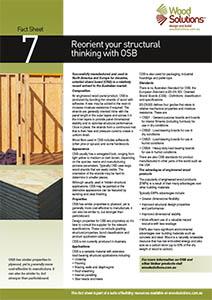
Fact Sheet 7 - Oriented strand board (OSB)
Successfully manufactured and used in North America and Europe for decades, oriented strand board (OSB) is a relatively recent entrant to the Australian market.
This fact sheet discusses its composition, appearance, properties, applications, standards and advantages.
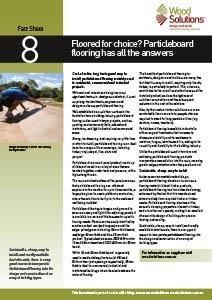
Fact Sheet 8 - Particleboard flooring
Cost-effective, long lasting and easy to install; particleboard flooring is widely used in residential, commercial and industrial projects.
This fact sheet discuses common sizes, properties and use of particleboard flooring.
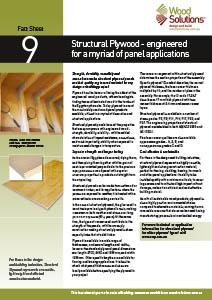
Fact Sheet 9 - Structural plywood
Strength, durability, versatility and ease-of-use make structural plywood panels an ideal quality engineered material for many design or building projects.
Plywood is the oldest of the engineered wood products, with archaeologists finding traces of laminated wood in the tombs of the Egyptian pharaohs. Today, plywood is one of the most widely used wood panel products available, utilised in a myriad of decorative and structural applications.
This fact sheet covers the properties, common sizes, grades and advantages of plywood.
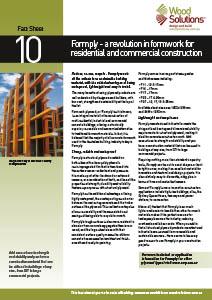
Fact Sheet 10 - Formply
Reduce, re-use, recycle - formwork plywood, or formply as it has become known - meets all the criteria for a sustainable building material, with the added advantages of being waterproof, lightweight and easy to install.
This fact sheet discussus the common sizes, applications and benefits of formply.
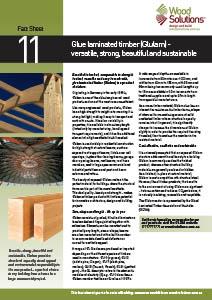
Fact Sheet 11 - Glulam
Beautiful, comparable in strength to steel, versatile and easy to work with, glued laminated timber (Glulam) is a widely adaptable product.
Originating in Germany in the early 1900’s, Glulam is one of the oldest engineered wood products and one of the most resource-efficient.
This fact sheet introduces the properties, applications and benefits of Glulam.
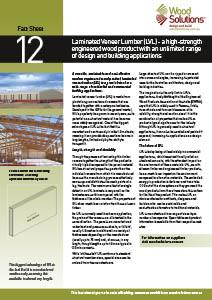
Fact Sheet 12 - Laminated veneer lumber (LVL)
A versatile, sustainable and cost-effective contemporary engineered wood product, laminated veneer lumber (LVL) is an excellent choice for a wide range of residential and commercial building applications.
This fact sheet discusses its properties, uses and advantages.
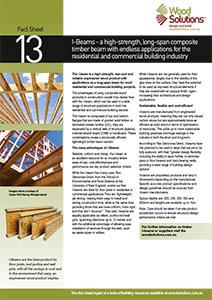
Fact Sheet 13 - I beams
I-beams are a high-strength, low-cost and reliable engineered wood product with applications as a long-span beam for a wide range of residential and commercial building projects.
This fact sheet discusses their adantages, common sizes and typical applications.
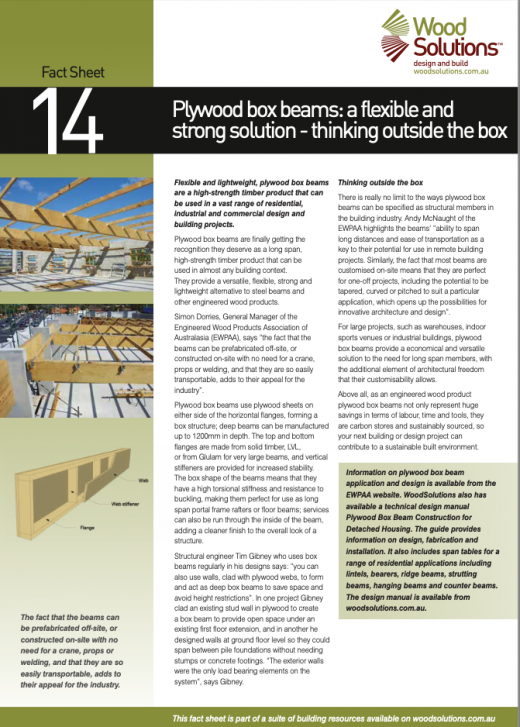
Fact Sheet 14 - Box Beams
Flexible and lightweight, plywood box beams are a high-strength timber product that can be used in a vast range of residential, industrial and commercial design and building projects.
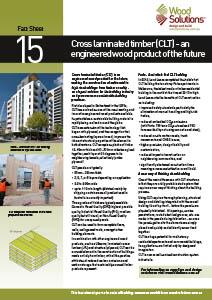
Fact Sheet 15 - Cross laminated timber (CLT)
First developed in Switzerland in the 1970s, CLT is one of the most exciting and innovative engineered wood products. Its potential as a sustainable building material for mid-rise and higher projects, is rapidly being realised, in Australia and internationally.
This fact sheet discusses some of the common sizes of CLT, its benefits and applications.
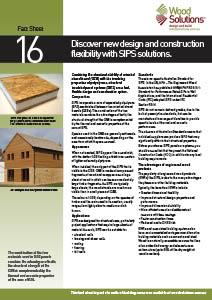
Fact Sheet 16 - Structural insulated panel systems (SIPS)
Combining the structural stability of oriented strand board (OSB) with the insulating properties of polystyrene, structural insulated panel systems (SIPS) are a fast, flexible design and construction option. They are more common in European and overseas markets than in Australia.
This fact sheet discusses their composition, appearance, applications, standards and advantages.
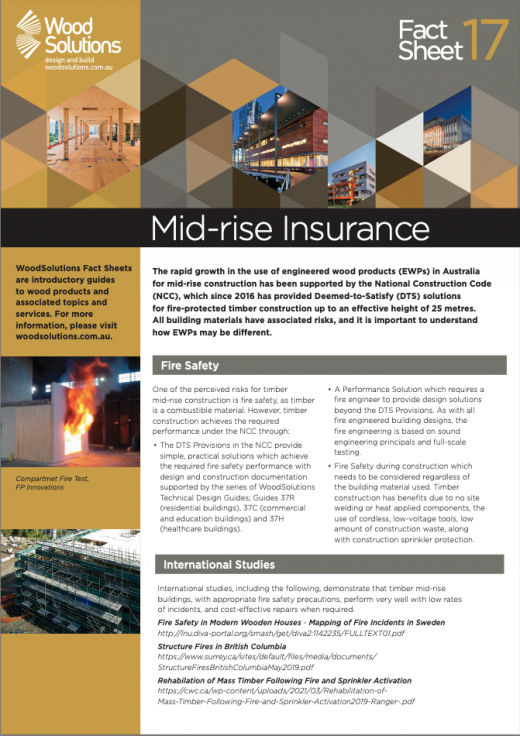
Fact Sheet 17 - Mid-rise Insurance
One of the perceived risks for timber mid-rise construction is fire safety, as timber is a combustible material. However, with appropriate knowledge and processes, timber construction can achieve the performance required under the NCC. This Fact Sheet explains how.
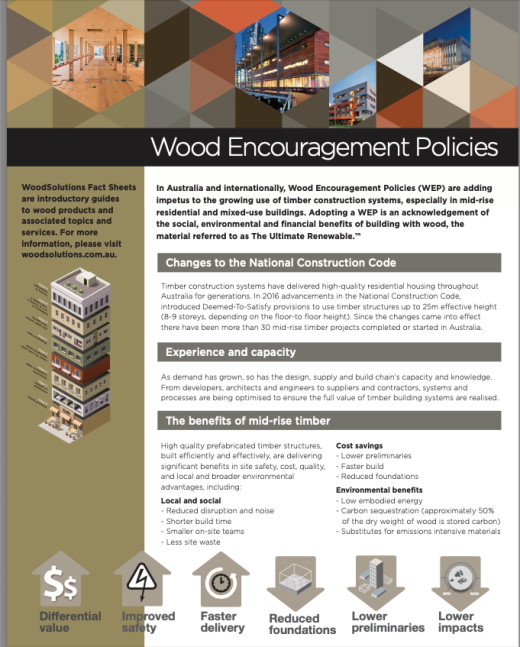
Fact Sheet 18 - Wood Encouragement Policies (WEP)
In Australia and internationally, Wood Encouragement Policies (WEP) are adding impetus to the growing use of timber construction systems, especially in mid-rise residential and mixed-use buildings. Adopting a WEP is an acknowledgement of the social, environmental and financial benefits of building with wood, the material referred to as The Ultimate Renewable™
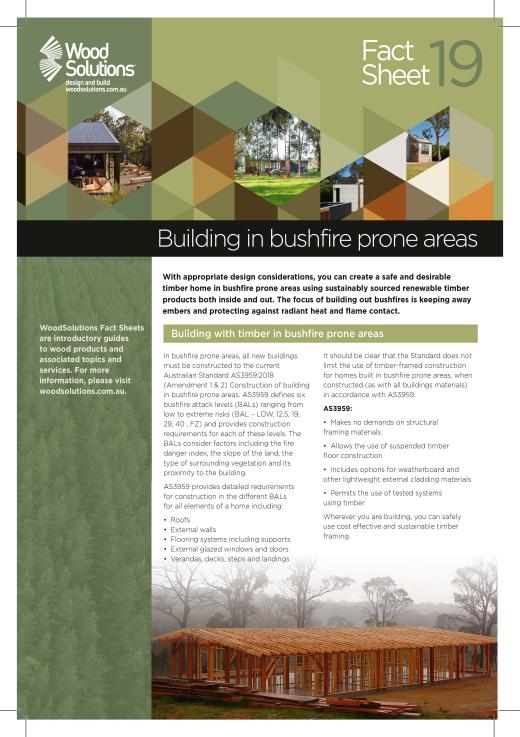
Fact Sheet 19 - Building in bushfire prone areas
With appropriate design considerations, you can create a safe and desirable timber home in bushfire prone areas using sustainably sourced, renewable timber products both inside and out. The focus of building out bushfires is keeping away embers and protecting against radiant heat and flame contact.
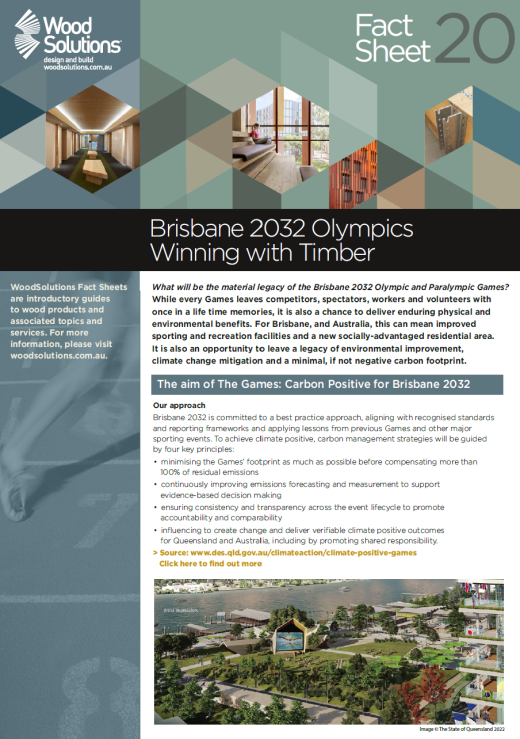
Fact Sheet 20 - Brisbane 2032 Olympics Winning with Timber
What will be the material legacy of the Brisbane 2032 Olympic and Paralympic Games?
While every Games leaves competitors, spectators, workers and volunteers with
once in a life time memories, it is also a chance to deliver enduring physical and
environmental benefits. For Brisbane, and Australia, this can mean improved
sporting and recreation facilities and a new socially-advantaged residential area.
It is also an opportunity to leave a legacy of environmental improvement,
climate change mitigation and a minimal, if not negative carbon footprint.
